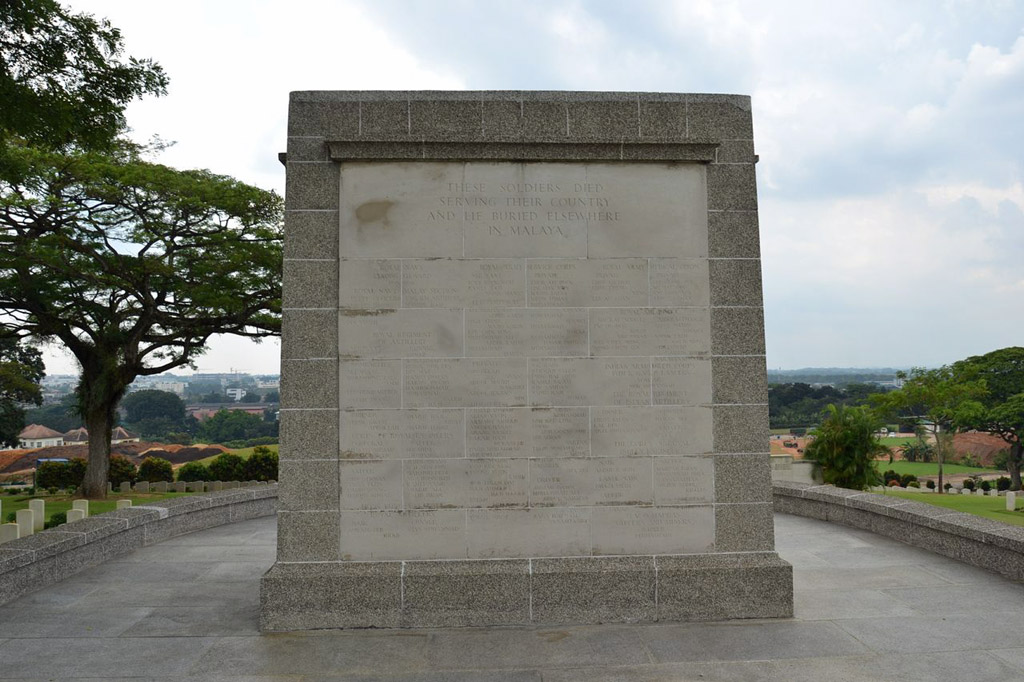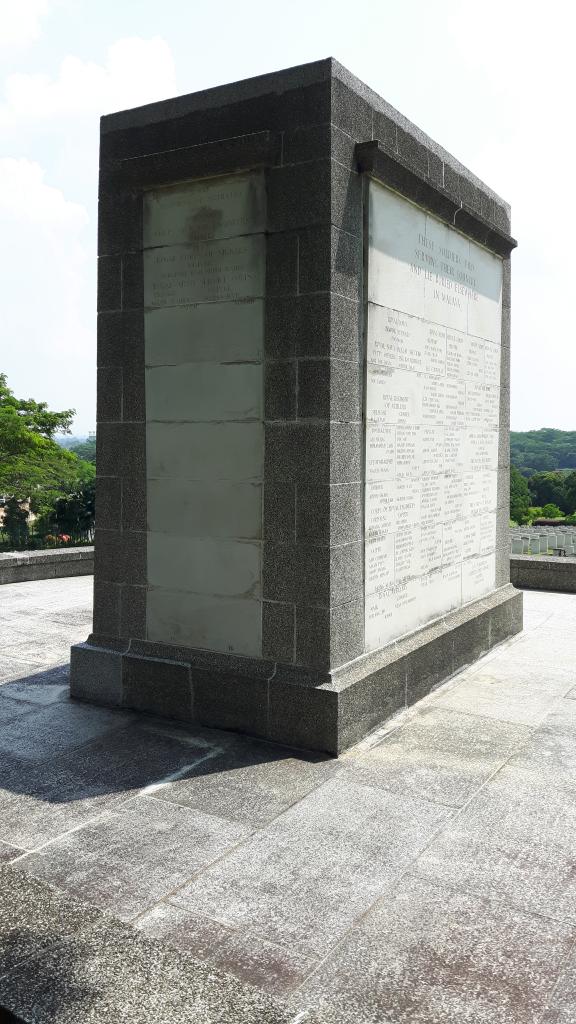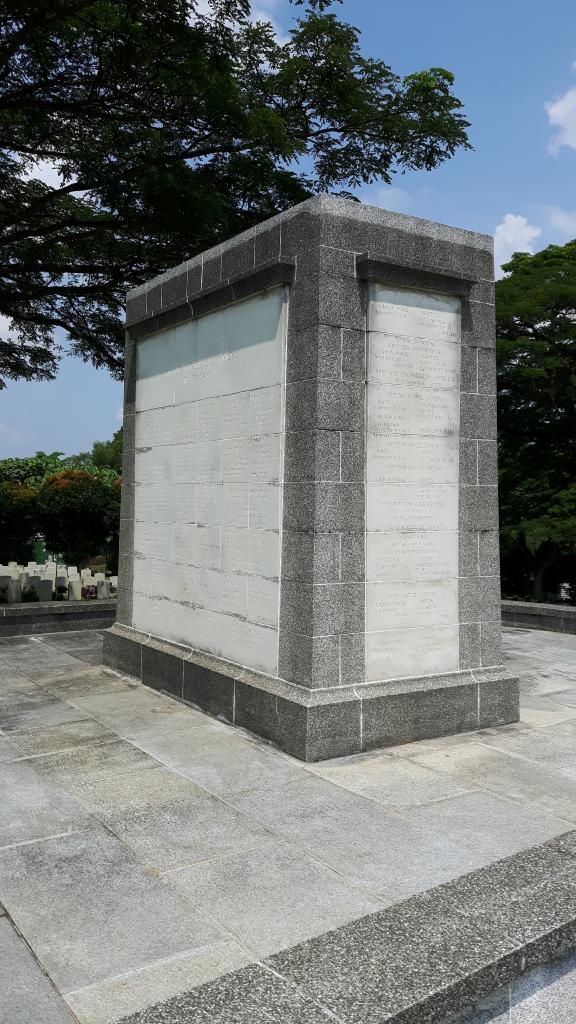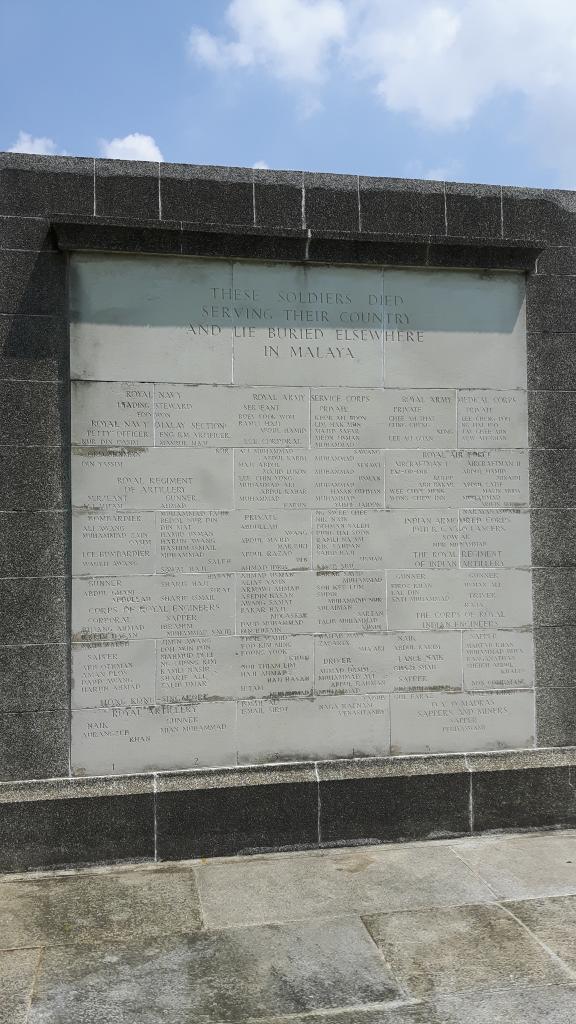Singapore (Unmaintainable Graves) Memorial
- Country Singapore
- Total identified casualties 255 Find these casualties
- Identified casualties from Second World War
- GPS Coordinates Latitude: 1.41837, Longitude: 103.75762
Location information
The Singapore (Unmaintainable Graves) Memorial stands within Kranji War Cemetery. Kranji War Cemetery is located at 9 Woodlands Road, at the intersection of Woodlands Rd and Turf Club Ave, 22 kilometres north of the city of Singapore. The Cemetery is known locally as Kranji Memorial, and one must be sure of the address before boarding a taxi as most taxi drivers do not know the Cemetery. There is a short, unmarked approach road to the cemetery from Woodlands Road, just to the south of Turf Club Ave. By train, take the North-South Line and alight at Kranji MRT train station (station no. NS 7). The distance from the train station to the cemetery is approximately 10 to 15 minutes away by foot. There are bus stops for the cemetery on Woodlands Road. Stop at no. 451119 (which is 2 bus stops away from Kranji Train station) or no. 45111 on the opposite side. Buses 160, 170, 178, 960, and 961 will take you there.
Visiting information
Kranji War Cemetery, in which the Memorial is located, is open every day 08:00-18:00. The cemetery is constructed on a hill with the means of access being via three flights of steps, rising over four metres from the road level. There is no disabled access at this site but if you wish to visit and need assistance please contact our Canada, Americas & Pacific Area Office in advance of your visit via enquiries@cwgc.org. We can then notify our local staff to expect you and assist with your visit.
History information
Before 1939 the Kranji area was a military camp and at the time of the Japanese invasion of Malaya, it was the site of a large ammunition magazine. On 8 February 1942, the Japanese crossed the Johore Straits in strength, landing at the mouth of the Kranji River within two miles of the place where the war cemetery now stands. On the evening of 9 February, they launched an attack between the river and the causeway. During the next few days fierce fighting ensued, in many cases hand to hand, until their greatly superior numbers and air strength necessitated a withdrawal.
After the fall of the island, the Japanese established a prisoner of war camp at Kranji and eventually a hospital was organised nearby at Woodlands.
After the reoccupation of Singapore, the small cemetery started by the prisoners at Kranji was developed into a permanent war cemetery by the Army Graves Service when it became evident that a larger cemetery at Changi could not remain undisturbed. Changi had been the site of the main prisoner of war camp in Singapore and a large hospital had been set up there by the Australian Infantry Force. In 1946, the graves were moved from Changi to Kranji, as were those from the Buona Vista prisoner of war camp. Many other graves from all parts of the island were transferred to Kranji together with all Second World War graves from Saigon Military Cemetery in French Indo-China (now Vietnam), another site where permanent maintenance could not be assured.
The Commission later brought in graves of both World Wars from Bidadari Christian Cemetery, Singapore, where again permanent maintenance was not possible.
There are now 4,458 Commonwealth casualties of the Second World War buried or commemorated at KRANJI WAR CEMETERY. More than 850 of the burials are unidentified. The Chinese Memorial in Plot 44 marks a collective grave for 69 Chinese servicemen, all members of the Commonwealth forces, who were killed by the Japanese during the occupation in February 1942.
First World War burials and commemorations number 64, including special memorials to three casualties known to have been buried in civil cemeteries in Saigon and Singapore, but whose graves could not be located.
Within Kranji War Cemetery stands the SINGAPORE MEMORIAL, bearing the names of over 24,000 casualties of the Commonwealth land and air forces who have no known grave. The land forces commemorated by the memorial died during the campaigns in Malaya and Indonesia or in subsequent captivity, many of them during the construction of the Burma-Thailand railway, or at sea while being transported into imprisonment elsewhere. The memorial also commemorates airmen who died during operations over the whole of southern and eastern Asia and the surrounding seas and oceans.
The SINGAPORE (UNMAINTAINABLE GRAVES) MEMORIAL, which stands at the western end of the Singapore Memorial, commemorates more than 250 casualties who died in campaigns in Singapore and Malaya, whose known graves in civil cemeteries could not be assured maintenance and on religious grounds could not be moved to a war cemetery.
The SINGAPORE CREMATION MEMORIAL, which stands immediately behind the Singapore Memorial, commemorates almost 800 casualties, mostly of the Indian forces, whose remains were cremated in accordance with their religious beliefs.
The SINGAPORE CIVIL HOSPITAL GRAVE MEMORIAL stands at the eastern end of the Singapore Memorial. During the last hours of the Battle of Singapore, wounded civilians and servicemen taken prisoner by the Japanese were brought to the hospital in their hundreds. The number of fatalities was such that burial in the normal manner was impossible. Before the war, an emergency water tank had been dug in the grounds of the hospital and this was used as a grave for more than 400 civilians and Commonwealth servicemen.
After the war, it was decided that as individual identification of the dead would be impossible, the grave should be left undisturbed. The grave was suitably enclosed, consecrated by the Bishop of Singapore, and a cross in memory of all of those buried there was erected over it by the military authorities. 108 Commonwealth military casualties buried in the grave are commemorated on the Singapore Civil Hospital Grave Memorial.
Kranji War Cemetery and the Singapore Memorial were designed by Colin St Clair Oakes.
Adjoining Kranji War Cemetery is KRANJI MILITARY CEMETERY, a substantial non-world war site of 1,422 burials, created in 1975 when it was found necessary to remove the graves of servicemen and their families from Pasir Panjang and Ulu Pandan cemeteries.





